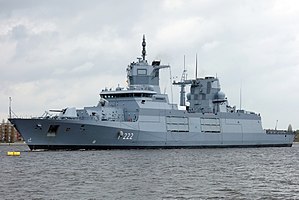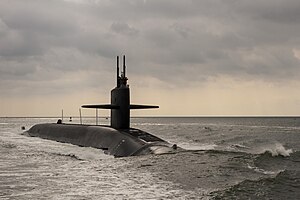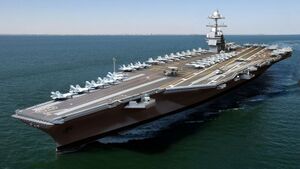Zamastanian Naval Forces: Difference between revisions
| Line 336: | Line 336: | ||
====Patrol vessels==== | ====Patrol vessels==== | ||
A patrol boat is a relatively small naval vessel generally designed for coastal defense duties. There have been many designs for patrol boats, though the navy currently only has a single class. They may be operated by a nation's navy or coast guard, and may be intended for marine ("blue water") or estuarine or river ("brown water") environments. The Navy's approximately 50 patrol ships are mainly used in home port patrols and drug interdiction missions. | A patrol boat is a relatively small naval vessel generally designed for coastal defense duties. There have been many designs for patrol boats, though the navy currently only has a single class. They may be operated by a nation's navy or coast guard, and may be intended for marine ("blue water") or estuarine or river ("brown water") environments. The Navy's approximately 50 patrol ships are mainly used in home port patrols and drug interdiction missions. Naming categories vary, but often follow full names of naval heroes, battles, or weather phenomena. | ||
{{div col|colwidth=10em}} | |||
*[[ZMS]] | |||
*[[ZMS]] | |||
*[[ZMS]] | |||
*[[ZMS]] | |||
*[[ZMS]] | |||
*[[ZMS]] | |||
*[[ZMS]] | |||
*[[ZMS]] | |||
*[[ZMS]] | |||
*[[ZMS]] | |||
*[[ZMS]] | |||
*[[ZMS]] | |||
*[[ZMS]] | |||
*[[ZMS]] | |||
*[[ZMS]] | |||
*[[ZMS]] | |||
*[[ZMS]] | |||
*[[ZMS]] | |||
*[[ZMS]] | |||
*[[ZMS]] | |||
*[[ZMS]] | |||
*[[ZMS]] | |||
*[[ZMS]] | |||
*[[ZMS]] | |||
*[[ZMS]] | |||
*[[ZMS]] | |||
*[[ZMS]] | |||
*[[ZMS]] | |||
*[[ZMS]] | |||
*[[ZMS]] | |||
*[[ZMS]] | |||
*[[ZMS]] | |||
*[[ZMS]] | |||
*[[ZMS]] | |||
*[[ZMS]] | |||
*[[ZMS]] | |||
*[[ZMS]] | |||
*[[ZMS]] | |||
*[[ZMS]] | |||
*[[ZMS]] | |||
*[[ZMS]] | |||
*[[ZMS]] | |||
*[[ZMS]] | |||
*[[ZMS]] | |||
*[[ZMS]] | |||
*[[ZMS]] | |||
*[[ZMS]] | |||
*[[ZMS]] | |||
*[[ZMS]] | |||
*[[ZMS]] | |||
*[[ZMS]] | |||
*[[ZMS]] | |||
*[[ZMS]] | |||
*[[ZMS]] | |||
*[[ZMS]] | |||
{{div col end}} | |||
====Submarines==== | ====Submarines==== | ||
Revision as of 18:27, 14 September 2021
| Zamastanian Naval Forces Z.N.F. | |
|---|---|
 Embelm of the Zamastanian Navy | |
| Active | September 3rd, 1805 |
| Country | Zamastan |
| Allegiance | Government of Zamastan, President of Zamastan |
| Branch | Navy |
| Size | Total - 296,500 |
| Fleet |
|
| Engagements | |
| Commanders | |
| President of Zamastan | Atticus Moreau |
| Secretary of Defense | Camille Boffrand |
| Secretary of the Navy | Antoine Porter |
| Chief of Naval Operations | Sam Armstrong |
| 1st Fleet Commander | Elliot Holloway |
| 2nd Fleet Commander | Ross Cummings |
| 6th Fleet Commander | Aubin Beauvais |
| 4th Fleet Commander | Drew Barr |
| 5th Fleet Commander | Rebecca Chaney |
The Zamastanian Naval Forces (ZNF), is the naval warfare force of Zamastan, operating under the overarching authority of the Zamastanian Armed Forces. It includes the Zamastanian Navy and the Marines. The Navy maintains a fleet of technologically sophisticated ships and submarines including seven aircraft carriers, amphibious transport docks, ballistic missile submarines, six nuclear fleet submarines, guided missile destroyers, frigates, corvettes, mine-countermeasure vessels and patrol vessels. It has 240 deployable combat vessels and more than 3,100 operational aircraft as of January 2020. The Zamastanian Air Force replenishes ZNF warships at sea, and augments the Navy's amphibious warfare capabilities through its three Bay-class landing ship vessels. It also works as a force multiplier for the Navy, often doing patrols that frigates used to do. The total displacement of the Navy is approximately 408,750 tonnes (706,759 tonnes including the Zamastan Fleet Auxiliary and Marines).
History
Personnel
Equipment
Ships
Aircraft carriers
An aircraft carrier is typically deployed along with a host of additional vessels, forming a carrier strike group. The supporting ships, which usually include three or four Aegis-equipped cruisers and destroyers, a frigate, and two attack submarines, are tasked with protecting the carrier from air, missile, sea, and undersea threats as well as providing additional strike capabilities themselves. Ready logistics support for the group is provided by a combined ammunition, oiler, and supply ship.
The Navy has a statutory requirement for a minimum of 6 aircraft carriers. The navy is currently consistant of seven Talon-class nuclear aircraft carriers, with the ZMS Gardner undergoing extensive systems and technologies testing until around 2021. All modern-day carriers are named after presidents of Zamastan, currently being Alistair Griffiths, Tyler Kordia, Thomas Dubois, Jean Levasseur, Caius Aebutius, Quintus Belisarius, and Hawk Gardner, while during the World War names were varied, often composed of military leader namesakes.
- ZMS Griffiths
- ZMS Kordia
- ZMS Dubois
- ZMS Levasseur
- ZMS Aebutius
- ZMS Belisarius
- ZMS Gardner (set to be renamed)
Amphibious warfare vessels
Amphibious assault ships are the centerpieces of Zamastanian amphibious warfare and fulfill the same power projection role as aircraft carriers. However, their striking force centers on land forces instead of aircraft. They deliver, command, coordinate, and fully support all elements of a 2,000-men-strong Unit in an amphibious assault using both air and amphibious vehicles.
Cruisers
Cruisers are large surface combat vessels that conduct anti-air/anti-missile warfare, surface warfare, anti-submarine warfare, and strike operations independently or as members of a larger task force. Modern guided missile cruisers were developed out of a need to counter the anti-ship missile threat facing the Zamastanian Navy. Cruisers are named after geographic names in Zamastan, often cities, rivers, or mountains.
- ZMS Monserrati
- ZMS Trisiona
- ZMS Maple Wind
- ZMS Clift
- ZMS Birchwood
- ZMS Abagene
- ZMS Tariel
- ZMS Tofiniua
- ZMS Durassi
- ZMS Leprino
- ZMS Jarossina
- ZMS Whiterock
- ZMS Abagene
- ZMS Grouse
- ZMS Qira
- ZMS Serenity
- ZMS Sundress
- ZMS Maina
- ZMS Brattollion
- ZMS Tronhede
- ZMS Fougere
- ZMS Alabaster
- ZMS Sunlam
- ZMS Elkhead
- ZMS Blythe
- ZMS Maycastle
- ZMS Torport
- ZMS Summercord
- ZMS Elmhill
- ZMS Dorburn
- ZMS Falwood
- ZMS Harboro
- ZMS Verrane
- ZMS Ellingter
- ZMS Northland
- ZMS Shawville
- ZMS Angenta
- ZMS Coviso
- ZMS Alcala
- ZMS Alkfort
- ZMS Lisney
- ZMS Dundare
- ZMS Winterschede
- ZMS Malnon
- ZMS Eastbar
- ZMS Siera
- ZMS Venpon
- ZMS Tralina
- ZMS Maycastle
- ZMS Calwaki
- ZMS Auckandia
- ZMS Verburg
- ZMS Tourzen
- ZMS Sadine
Destroyers

Destroyers are multi-mission medium surface ships capable of sustained performance in anti-air, anti-submarine, anti-ship, and offensive strike operations. Like cruisers, guided missile destroyers are primarily focused on surface strikes using the Firebird Land Attack Missiles and fleet defense through missile systems. As in the case of frigates, destroyers are named after Navy, Marine, and Coast Guard heroes, with its flagship destroyer being named the ZMS Lance Pelio after famed World War Admiral Lance Pelio.
- ZMS Lance Pelio
- ZMS Tobias
- ZMS Altendorf
- ZMS Jackson
- ZMS Loan
- ZMS Biggy
- ZMS Cassiday
- ZMS Shorthand
- ZMS Keiper
- ZMS Andrews
- ZMS Church
- ZMS Lennox
- ZMS Raydan
- ZMS Hill
- ZMS Herring
- ZMS Byrne
- ZMS Gallagher
- ZMS Tecna
- ZMS Moss
- ZMS Brady
- ZMS Engebos
- ZMS Guild
- ZMS Artego
- ZMS Feist
- ZMS Guillaume
- ZMS Vidal
- ZMS Saunier
- ZMS Émilien
- ZMS Adnet
- ZMS Mathieu
- ZMS Boudier
- ZMS Charbonneau
- ZMS Jacquet
- ZMS Ilonna
- ZMS Fragale
- ZMS Tolomeo
- ZMS Mercia
- ZMS Emerson
- ZMS Galena
- ZMS Westenra
- ZMS Kamura
- ZMS Fortuna
- ZMS Peters
- ZMS Rolando
- ZMS Pellitteri
- ZMS Labruzzo
- ZMS Lieto
- ZMS Goffredo
- ZMS Crose
- ZMS Ciancio
- ZMS Narsete
- ZMS Euseo
- ZMS Celio
- ZMS Natale
- ZMS Tomasulo
- ZMS Eustorgio
- ZMS Scarangella
- ZMS Federico
- ZMS Girolamo
- ZMS Crispino
- ZMS Frattaroli
- ZMS Querin
- ZMS Amaury
- ZMS Allemand
- ZMS Quentin
- ZMS Rémy
- ZMS Natanael
- ZMS LaRue
- ZMS Djeferson
- ZMS Pascal
- ZMS Gigot
- ZMS Zacharie
- ZMS Peletier
- ZMS Gounelle
- ZMS Granet
- ZMS Bacque
- ZMS Gabriel
- ZMS Barbeau
- ZMS Coquelin
- ZMS Lucien
- ZMS Mesny
Frigates and Littoral combat ships

Modern frigates and littoral combat ships mainly perform anti-submarine warfare for carrier and expeditionary strike groups and provide armed escort for supply convoys and merchant shipping. They are designed to protect friendly ships against hostile submarines in low to medium threat environments, using torpedoes and helicopters. Independently, frigates are able to conduct counterdrug missions and other maritime interception operations. As in the case of destroyers, frigates are named after Navy, Marine, and Coast Guard heroes, though the flagship of Zamastanian frigates and Littoral combat ships is named after President Avi Taures, and its two support vessels are named the ZMS August Vendetta and the ZMS Redeemer after code names used during the World War.
Tavoka-class
Osprey-class
- ZMS Avi Taures
- ZMS Harren
- ZMS Harrell
- ZMS Galloway
- ZMS Browning
- ZMS Kayden
- ZMS Vovk
- ZMS Stirrat
- ZMS Cisneros
- ZMS Arthyen
- ZMS Tregloyne
- ZMS Cengor
- ZMS James
- ZMS Nicholls
- ZMS Pellow
- ZMS Kitto
- ZMS Cenmin
- ZMS Jenken
- ZMS Conredeu
- ZMS Growden
- ZMS Chalke
- ZMS Marhe
- ZMS Rablin
- ZMS Morrow
- ZMS Hahn
- ZMS Lorenno
- ZMS Collier
- ZMS Houghton
Mine countermeasures ships
Mine countermeasures vessels are a combination of minehunters, a naval vessel that actively detects and destroys individual naval mines, and minesweepers, which clear mined areas as a whole, without prior detection of the mines. The navy has approximately a dozen of these in active service, but the mine countermeasure (MCM) role is also being assumed by the incoming classes of littoral combat ships. MCM vessels have mostly legacy names of previous Zamastanian Navy ships, especially World War-era minesweepers.
Patrol vessels
A patrol boat is a relatively small naval vessel generally designed for coastal defense duties. There have been many designs for patrol boats, though the navy currently only has a single class. They may be operated by a nation's navy or coast guard, and may be intended for marine ("blue water") or estuarine or river ("brown water") environments. The Navy's approximately 50 patrol ships are mainly used in home port patrols and drug interdiction missions. Naming categories vary, but often follow full names of naval heroes, battles, or weather phenomena.
Submarines

All current and planned Zamastanian Navy submarines are nuclear-powered, as only nuclear propulsion allows for the combination of stealth and long duration, high-speed sustained underwater movement that makes modern nuclear submarines so vital to a modern blue-water navy. The Zamastanian Navy operates three types: ballistic missile submarines, guided missile submarines, and attack submarines. Navy (nuclear) ballistic missile submarines carry the stealthiest leg of the Zamastanian strategic triad (the other legs are the land-based Zamastanian strategic missile force and the air-based Zamastanian strategic bomber force). The primary missions of attack and guided missile submarines in the Navy are peacetime engagement, surveillance and intelligence, special operations, precision strikes, and control of the seas. Submarines in the Zamastanian navy are named after famed admirals and fleet commanders.
- ZMS Serge
- ZMS Bernier
- ZMS Hugues
- ZMS Ruddigan
- ZMS Carré
- ZMS Bessette
- ZMS Houdin
- ZMS Jordan
- ZMS Chappuis
- ZMS Estienne
- ZMS Antoine
- ZMS Corriveau
- ZMS Droz
- ZMS Boisselot
- ZMS Roger
- ZMS Damien
- ZMS Guilloux
- ZMS Sacha
- ZMS Barreau
- ZMS Iudnerth
- ZMS Trevose
- ZMS Hedrek
- ZMS Dew
- ZMS Curnow
- ZMS Cador
- ZMS Tregidgo
- ZMS Ruman
- ZMS Stephens
- ZMS Yestin
- ZMS Bosustow
- ZMS Louenan
- ZMS Spargo
- ZMS Rewan
- ZMS Trevethan
- ZMS Gerens
- ZMS Billings
Aircraft

Carrier-based aircraft are able to strike air, sea, and land targets far from a carrier strike group while protecting friendly forces from enemy aircraft, ships, and submarines. In peacetime, aircraft's ability to project the threat of sustained attack from a mobile platform on the seas gives United States leaders significant diplomatic and crisis-management options. Aircraft additionally provide logistics support to maintain the navy's readiness and, through helicopters, supply platforms with which to conduct search and rescue, special operations, anti-submarine warfare (ASW), and anti-surface warfare (ASuW).
The Zamastanian Navy began to research the use of aircraft at sea in the 1920s, with Lieutenant Grayson Hedimeri becoming the first naval aviator on 4 January 1921, and commissioned its first aircraft carrier, the ZMS Almighty, in 1926. Zamastanian naval aviation fully came of age in the World War, when it became clear following the firebombing raid of Titania, the Battle of the Strait of Cranes, and the Battle of Novap that aircraft carriers and the planes that they carried had replaced the battleship as the greatest weapon on the seas. Leading navy aircraft in the World War included the Z-4F Wildcat and the Z-6F Hellcat. Navy aircraft also played a significant role in conflicts during the following Cold War years, with the Z-10 Harrier becoming a military icon of the era. The navy's current primary fighter and attack airplanes are the multi-mission Z-14 Osprey fighter jet.
Operations
The Zamastanian Navy has 6 active fleets, each helmed by one nuclear aircraft carrier. The fleets and their regional fields of operation are;
- 1st Fleet - Eastern Olympic Ocean; West Euronia, East Nortua, Northeast Adula
- 2nd Fleet - Adula-Nortua Divide; South Nortua, North Adula
- 3rd Fleet - Eastern Toyana Ocean; West and North Ausiana, Southern Euronia
- 4th Fleet - Western Toyana Ocean; South and East Adula, Antartique
- 5th Fleet - North Samson Ocean; East Euronia, West Nortua
- 6th Fleet - South Samson Ocean; East Ausiana, West Adula
Installations
The size, complexity, and international presence of the Zamastanian Navy requires a large number of navy installations to support its operations. While the majority of bases are located inside Zamastan itself, the Navy maintains a significant number of facilities abroad, either in Zamastanian-controlled territories or in foreign countries under a Status of Forces Agreement (SOFA).
National Bases
The Zamastanian Naval Forces operates fourteen naval bases in the 17 provinces of Zamastan.
- ZNB Tofino
- ZNB Jade Harbor
- ZNB White Rock
- ZNB Point Tarin
- ZNB Alabaster
- ZNB Fougere
- ZNB Svalberg
- ZNB Tregueux
- ZNB Anchorhead
- ZNB Alutia
- ZNB Titania
- ZNB Auckandia
- ZNB Gangkou
- ZNB Holish Islands
Bases in Foreign Countries
The largest overseas base is the Zamastan Fleet Activities (ZFA) Sulifa in Sulifa City, Sulifa, which serves as the home port for the navy's largest forward-deployed fleet (4th Fleet) and is a significant base of operations in the Western Toyana Ocean. Other large naval installations include facilities in Hapsoneau, Elborra; Courbagne, New Elkland; Vongane, Quetana; Singana, Siniapore; Gutaai, Jyau; Allengin, Elbresia; and Ruthin, Cadair.
- ZFA Sulifa (Sulifa)
- ZFA Hapsoneau (Elborra)
- ZFA Courbagne (New Elkland)
- ZFA Vongane (Quetana)
- ZFA Singana (Siniapore)
- ZFA Gutaai (Jyau)
- ZFA Allengin (Elbresia)
- ZFA Ruthin (Cadair)
- ZFA Balgita (Constantio)
- ZFA Amstelveen (Vulkaria)
- ZFA Tarijibar (Emmiria)
- ZFA Beresa (Saint Croix and Bens)
Notable Sailors
Many past and present Zamastanian historical figures have served in the navy. Some of the most notable individuals who served in the navy include Admirals Jarris Tavoka and Percy Tavoka... ---INCOMPLETE---



